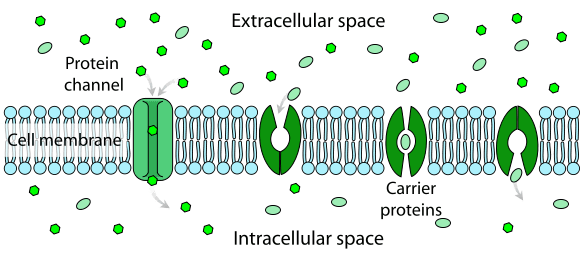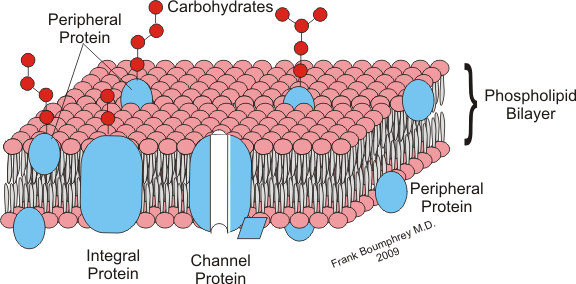Difference Between Intrinsic and Extrinsic Proteins
Key Difference – Intrinsic vs Extrinsic Proteins
Cells are surrounded by cell membranes, which are made up of a lipid bilayer, proteins, and carbohydrates. Proteins are embedded in the lipid bilayer of the cell membrane. Cells constantly transport ions and other necessary molecules in and out the cells through these proteins. Some proteins extend through both layers while some proteins extend from one side of the membrane. The proteins interact that with cell membrane are known as membrane proteins. There are two membrane proteins known as intrinsic and extrinsic proteins. Intrinsic proteins are the transmembrane proteins which are embedded in the lipid bilayer. They extend from one side to the other side. Extrinsic proteins are the membrane proteins which are located outside the membrane and bound weakly to the membrane. This is the key difference between intrinsic and extrinsic proteins.
CONTENTS
1. Overview and Key Difference
2. What are Intrinsic Proteins
3. What are Extrinsic Proteins
4. Similarities Between Intrinsic and Extrinsic Proteins
5. Side by Side Comparison – Intrinsic vs Extrinsic Proteins in Tabular Form
6. Summary
What are Intrinsic Proteins?
Intrinsic proteins are a type of membrane proteins which are important in transporting ions or molecules across the cell membrane. Intrinsic proteins are embedded in the membrane. Some intrinsic proteins span completely through the membrane to the both sides of the membrane while some intrinsic proteins are only partially embedded in the membrane. Intrinsic proteins that extend from one side of the membrane to the other side are referred as transmembrane proteins. Transmembrane proteins work as channel proteins to move molecules and ions across the membrane in and out the cell. These proteins have pores inside their structure.

Intrinsic proteins have one or more domains embedded through the phospholipid bilayer. Intrinsic proteins are more hydrophobic and less hydrophilic. Hydrophobic side chains are important in anchoring fatty acyl groups of the lipid bilayer. Most of the membrane spanning domains are alpha helices or beta strands.
What are Extrinsic Proteins?
Extrinsic proteins are a type of membrane proteins which are loosely bound to the membrane from the outside. They are bound with weak molecular interactions such as ionic, hydrogen and/or Van der Waals bonds. Extrinsic proteins are also known as peripheral proteins. These proteins are hydrophilic in nature. They interact with integral proteins or with polar heads of the lipid molecules. Peripheral proteins on the extracellular membrane work as receptors in cell to cell signaling or interactions. Peripheral proteins which are in the cytosolic face work as cytoskeletal proteins such as spectrin, actin, protein kinase C, etc. Some peripheral proteins are involved in signal transduction.

What are the Similarities Between Intrinsic and Extrinsic Proteins?
- Intrinsic and extrinsic proteins are membrane proteins.
What is the Difference Between Intrinsic and Extrinsic Proteins?
Intrinsic vs Extrinsic Proteins | |
| Intrinsic proteins are the membrane proteins which are embedded completely or partly through the lipid bilayer of the membrane. | Extrinsic proteins are the loosely bound proteins that are located outside the membrane. |
| Synonyms | |
| Intrinsic Proteins are also known as integral proteins or internal proteins. | Extrinsic Proteins are also known as peripheral proteins or external proteins. |
| Location | |
| Intrinsic proteins are embedded completely or partially through the membrane. Sometimes they span across the membrane several times. | Extrinsic proteins are bound to cell membrane from outside. |
| Proportion | |
| Intrinsic proteins account for approximately 70% of the membrane proteins. | Extrinsic proteins account for approximately 30 % of the membrane proteins. |
| Hydrophilic and Hydrophobic Nature | |
| Intrinsic Proteins are more hydrophobic and less hydrophilic. | Extrinsic Proteins are more hydrophilic and less hydrophobic. |
| Removal from the Membrane | |
| Intrinsic proteins cannot be easily removed from the membrane. | Extrinsic proteins can be easily removed from the membrane. |
| Functions in the Membrane | |
| Intrinsic proteins act as carrier proteins, enzymes, permeases, transport channels, etc. | Extrinsic proteins act as receptors, antigens, recognition centers, etc. |
| Bonds Formed with Cell Membrane | |
| Intrinsic Proteins are embedded in the lipid bilayer, forming strong interactions. | Extrinsic Proteins are loosely bound to the membrane by weak non-molecular interactions. |
| Examples | |
| Glycophorin, rhodopsin, NADH dehydrogenase, etc. are intrinsic proteins. | Cytochrome C, erythrocyte spectrin, etc. are extrinsic proteins. |
Summary – Intrinsic vs Extrinsic Proteins
Membrane proteins are classified into two groups known as intrinsic and extrinsic proteins based on the nature of the interaction between proteins and the membrane. Intrinsic membrane proteins are embedded in the membrane. They are permanently attached to the membrane. Extrinsic proteins are attached to membrane from the outside. They are held by weak molecular attractions such as ionic, hydrogen, or Van der Waals bonds. This is the difference between intrinsic and extrinsic proteins.
Download PDF Version of Intrinsic vs Extrinsic Proteins
You can download PDF version of this article and use it for offline purposes as per citation notes. Please download PDF version here Difference Between Intrinsic and Extrinsic Proteins.
References:
1. Lodish, Harvey. “Membrane Proteins.” Molecular Cell Biology. 4th edition. U.S. National Library of Medicine, 01 Jan. 1970. Web. Available here. 17 July 2017.
2. Membrane Proteins. National Tsing Hua University., n.d. Web. Available here. 18 July 2017.
Image Courtesy:
1. “Scheme facilitated diffusion in cell membrane-en” By LadyofHats Mariana Ruiz Villarreal – Own work. Image renamed from Image:Facilitated_diffusion_in_cell_membrane.svg, Public Domain) via Commons Wikimedia
2. “Cell membrane3” By Boumphreyfr – Own work (CC BY-SA 3.0) via Commons Wikimedia
ncG1vNJzZmivp6x7pbXFn5yrnZ6YsqOx07CcnqZemLyue8OinZ%2Bdopq7pLGMm5ytr5Wau261za2poqajnrBurc2dZK%2BrXZrFtb7Ip6qim12lv7DAxKKlrGc%3D